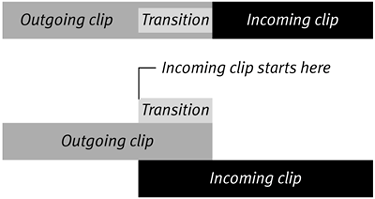Understanding Transitions and the Single-Track Edit
| Liquid Edition uses a single-track edit system, which means all the media clips exist on a single track. However, you can have as many tracks as you want, and then you can combine them together to create some spectacular effects. On the opposite side of the fence is the A/B roll method, which some other NLE programs use. This method needs three lines to create a transition; these lines are often static and can't be customized to your individual needs. Both single-track edit and A/B roll have advantages and disadvantages, particularly when it comes to the everyday use of transitions, which you look at in the next few pages. The A/B roll methodThe A/B roll method uses the concept of two tracksTrack A at the top, and Track B at the bottomand in between them, you insert a transition. Figure 8.1 shows a graphical representation of this. The mark-in point of the clip on Track B is the start of the transition; the mark-out point of the clip on Track A is the end of the transition. Figure 8.1. The A/B roll method with overlapping clips.
The A/B roll method is easy to understand visually and thus easier to understand on straightforward projects. You simply position the clips to overlap and then place the transition in the middle to fill the overlapping gap. But you may encounter a problem. Suppose you want to add a title above Track A and then add a transition at the beginning of that title so that it fades into the rest of the track smoothly. Well, you can't. Your only option is to alter the transparency levels of the title, but this isn't going to help you if you want a much more advanced type of transition, such as a band wipe or a water ripple. The single-track edit systemIn contrast, the single-track edit system is a little more complex on the surface. The clips still overlap, but you can't see this overlap like you can in the A/B roll method. Instead, the clips are snuggled in behind each other (Figure 8.2). You can still manipulate the clips in the Trim Editor, but how you do this isn't quite as obvious as being able to see the overlapping gap between twp clips as is shown using the A/B roll system. Figure 8.2. The top image shows the single track edit with hidden overlapping clips. Below this is a "side-on" graphical representation of that same image.
This makes using the single-track edit system a little more challenging, but not dramatically so. It's not as if you have to be a nuclear physicist to understand the concept, but the process is a little more cerebral than the building-block system used by the A/B roll method. You'll be happy to know there is an advantage to using this method that should alleviate any potential headaches you feel coming on. Unlike the A/B roll method, the single-track edit system can support transitions on any video clip on any track. This means that if you need a transitionregardless of its complexity (take the example of adding a title or any other clip above your main clips, for instance)you can do this. It's not a problem, as you can see in Figure 8.3. Figure 8.3. Two video clips are midway through a Dissolve, while over the top a title is coming to the end of a water drop transition. This clear technical advantage goes a long way toward explaining why many NLE software programs prefer the single-track edit system to the A/B roll method. |
EAN: 2147483647
Pages: 245
- ERP Systems Impact on Organizations
- Challenging the Unpredictable: Changeable Order Management Systems
- ERP System Acquisition: A Process Model and Results From an Austrian Survey
- Intrinsic and Contextual Data Quality: The Effect of Media and Personal Involvement
- A Hybrid Clustering Technique to Improve Patient Data Quality
- Linking the IT Balanced Scorecard to the Business Objectives at a Major Canadian Financial Group
- Measuring ROI in E-Commerce Applications: Analysis to Action
- Technical Issues Related to IT Governance Tactics: Product Metrics, Measurements and Process Control
- Governance in IT Outsourcing Partnerships
- Governance Structures for IT in the Health Care Industry

